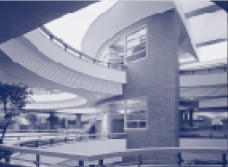SC Johnson Worldwide Professional Headquarters
Project Overview
The new SC Johnson facility was designed to meet the company’s organizational needs, while setting a new standard for environmentally responsible building. The design team integrated sustainability in the project by establishing environmental objectives at the outset. At about $130/SF for the building, the facility cost 10-15 percent less than the U.S. average for traditional office and lab buildings.
Land Use & Site Ecology
A low-maintenance site design incorporated a major regional drainage system, discovered beneath the site, using constructed ponds and wetlands to clean contaminated upstream runoff before release. Native and drought tolerant plants, such as prairie grass and wild flowers, were restored to the site, saving SC Johnson as much as $2,000 per acre in annual maintenance costs.
Light & Air
Maximizing daylight was the most important influence on the building’s shape. A floor-to-floor height of 17 feet was required to accommodate laboratory piping and ductwork, permitting the use of 14-foot high ceilings in the office areas. On the southern side of the building, large windows with light shelves draw natural light into office floors, which are also lit from the central atrium skylight.
The building’s raised floor is a “charged plenum” that supplies air to each workstation through a Johnson Controls “Personal Environmental Module,” allowing each person to individually control heating and cooling at his or her workstation. Occupancy sensors shut the system off when the individual leaves the space. Considerable first cost savings were realized, since the system reduced the HVAC capacity requirements and required less ductwork.
Energy Flows & Energy Future
Energy usage is 60 percent below the average for similar buildings, even less than the projected gross annual energy consumption of 73,000 BTU/SF. This reduced energy consumption will save SC Johnson nearly $100,000 per year.
Materials & Construction
During construction, 86 tons of material waste, including metal, glass, wood, cardboard, concrete, and drywall, were recycled. Material suppliers were also required to take back pallets and packaging, and they made scrap wood available for use by local residents.



